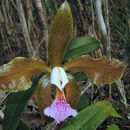en
names in breadcrumbs


Cattleya orchids are among the most familiar orchids in the world. The genus includes roughly 50 known species, all native to the New World tropics, but an enormous number of hybrid forms have been produced as well, both by crossing different Cattleya species with each other and by crossing Cattleya species with species in related genera. Cattleya are epiphytes, growing on trees or rocks. Like many epiphytic orchids, cattleyas have water-storage organs (known as "pseudobulbs") and large, fleshy roots with a spongy, water-retaining covering. Cattleya flowers are showy and long-lasting and often very fragrant. The flowers of the largest modern hybrids can exceed eight inches in diameter, while the smallest hybrids have flowers of just two to three inches, often exceeding the size of the plant. For most of the second half of the 20th century, and to some degree still, Cattleya was the "standard" orchid to which other orchids were compared by growers. (Fitch 2004; Banks 2005; Cattleya Source website)
Well into the early 1800s, epiphytic orchids were widely (and erroneously) believed to be parasitic on the trees on which they were found, feeding on their sap, leading to the persistent failure of many efforts to bring beautiful new orchids into cultivation. By the time cattleyas were being imported from their native lands in significant numbers, however, the challenges of growing these orchids had already been largely resolved. (Chadwick and Chadwick 2006)
By the mid-19th century, Cattleya orchids were extremely popular with orchid hobbyists in Europe--and quickly became big business as well. In the 1920s, Lewis Knudson, an American researcher, developed a sterile growing technique that dramatically reduced seedling mortality and represented an enormous efficiency improvement for commercial growers. Cattleyas became an important source of cut flowers for florists in the U.S., as they had been for some years in Europe, where the use of these expensive flowers was a status symbol. In the 1930s and 1940s in the U.S., Cattleya orchids replaced camellias and gardenias as the classic flowers for use in corsages. By the 1950s, however, Cymbidium orchids were replacing cattleyas for use in corsages. Cymbidiums were longer-lasting and were smaller and more compact, yet still large enough to make a corsage from a single flower. They also traveled better and were less expensive to grow. In fact, cymbidiums were so much cheaper than cattleyas that the cattleya market for corsages faded away. However, cymbidiums became so cheap that their glamour quickly faded and the market for orchid corsages in general declined. Although the orchid corsage market was much diminished, the second half of the 20th century saw an explosion in orchid breeding for the cut flower industry and orchid hobbyists. In the 1960s, a new, far more efficient, method of cloning orchids was developed in France, dramatically reducing the cost of propagating new and unusual varieties. Today, cattleyas are available in a dazzling array of colors, sizes, shapes, textures, and fragrances, although many of the fine old varieties are no longer commercially available. (Chadwick and Chadwick 2006)
Cattleya (/ˈkætliə/)[2] is a genus of orchids from Costa Rica south to Argentina.[1] The genus is abbreviated C in trade journals.[3]
Epiphytic or terrestrial orchids with cylindrical rhizome from which the fleshy noodle-like roots grow. Pseudobulbs can be conical, spindle-shaped or cylindrical; with upright growth; one or two leaves growing from the top of them. The leaves can be oblong, lanceolate or elliptical, somewhat fleshy, with smooth margin. The inflorescence is a terminal raceme with few or several flowers. Flowers have sepals and petals free from each other; the lip or labellum (lowermost petal), usually has a different coloration and shape from the rest of the flower and covers in part the flower column forming a tube. There are four pollinia (bag-like organs that contain pollen). The fruit is a capsule with many small seeds.[4][5][6]
The genus was named in 1824 by John Lindley after horticulturalist William Cattley. Cattley obtained a specimen of then unnamed Cattleya labiata from William Swainson who had discovered the new plant in Pernambuco, Brazil, in 1817. The plant successfully bloomed under the care of Cattley and it became the type specimen from which Lindley described C. labiata.[7]
Currently accepted species and subgeneric division within genus Cattleya are:[8][9][10][11][12][13]
Currently accepted natural hybrids are:[13]
Hybrids of Cattleya and other genera are placed in the following nothogenera:
Cattleya (/ˈkætliə/) is a genus of orchids from Costa Rica south to Argentina. The genus is abbreviated C in trade journals.